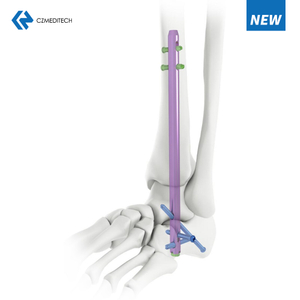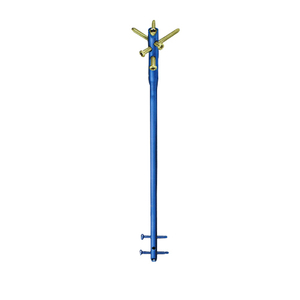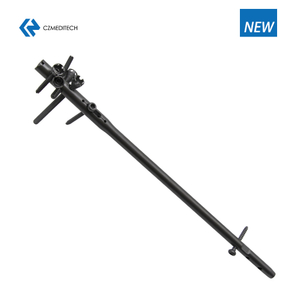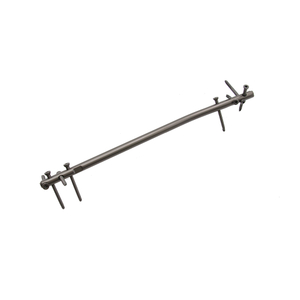Product operation details video
CZMEDITECH Femoral Reconstruction Nail
Femoral Recon Nail is designed to help treat various fractures of the femur. Different nails are available to be placed through the tip of the Greater Trochanter. Screws are placed through the nail to secure the implant in place and maintain length and alignment while healing occurs. The nails have multiple screw holes in the proximal body to allow surgeons to address different fracture types. Proximal and distal slots allow for compression or dynamization across a fracture.
Femoral Recon Nail Introduction
Femoral Recon Nail System offers an extensive range of surgical entry points and locking options to meet more surgeons’ needs for femoral shaft fractures.
Designed for anatomical fit
Nail designed to better fit patient anatomy and help avoid impinging anterior cortex compared to nails with a larger radius of curvature.
Reduced procedural complexity
Femoral Recon Nail instrumentation includes features designed to reduce surgical complexity facilitating intraoperative visualization, implant positioning and alignment as well as ease of use for OR staff.
Proximal locking options
Choice of standard and reconstruction locking modes allows for the treatment of a variety of femoral fracture patterns and locations.
Distal locking options
Equipped with four distal locking options, including an oblique distal hole to better target bone in the condyles and an A/P hole that provides an optional purchase point.
Entry point selection
Greater Trochanter and Piriformis Fossa entry point nail designs to accommodate varying patient anatomies and surgeon preference.
Advanced nail design
Femoral Recon Nails design offers great flexibility
Different Nails for left and right femur
Anatomic bend for ease in insertion and extraction
Cannulation of all nails for guided insertion in reamed and unreamed technique
Large portfolio with nail diameters ranging from Dia 9 to 11 mm and lengths ranging from 320 to 420 mm
Versatile locking configuration for static, dynamic and standard locking
Femoral Recon Nails available in Titanium and SS 316L
Unique distal locking options
The unique distal combination hole enables the optimal locking for every anatomical situation and fracture type. The surgeon can use standard locking (with two locking screws). The end cap allows for angular stable locking of the most distal locking implant in both configurations.
End caps
Self-retaining Screw driver for effortless and secure end cap pick-up and insertion
Possibility to block most proximal locking screw for absolute angular stability
End cap prevents ingrowth of tissue and facilitates nail removal
Locking screws
The 6.4 mm Cannulated Lag Screws have a unique thread design that provide an excellent grip. Improved front cutting flutes allow for lesser insertion torque and thinner flanks for less bone removal.
Secure placement of the Lag Screws within small neck diameters can be achieved due to separating the two 6.4 mm lag screws and distance between the 6.4 mm Lag screws.
The distal locking configuration features a round and an oblong hole to allow for static and / or dynamic distal locking.
5 mm cortical screws, common to the Femoral Recon Nails, are designed to simplify the surgical procedure and promote a minimally invasive approach.
Self-holding Screw driver for effortless and secure locking screw pick-up.
Double thread for more contact points leading to enhanced stability
Larger cross-section for improved mechanical resistance
Thread closer to screw head providing better bone purchase and improved stability
Self-holding Screw driver for effortless and secure locking screw pick-up
English
Français
Русский
Español
العربية
Português
Deutsch
italiano
日本語
한국어
Nederlands
Tiếng Việt
ไทย
Polski
Türkçe
አማርኛ
ພາສາລາວ
ភាសាខ្មែរ
Bahasa Melayu
ဗမာစာ
தமிழ்
Filipino
Bahasa Indonesia
magyar
Română
Čeština
Монгол
қазақ
Српски
हिन्दी
فارسی
Kiswahili
Slovenčina
Slovenščina
Norsk
Svenska
українська
Ελληνικά
Suomi
Հայերեն
עברית
Latine
Dansk
اردو
Shqip
বাংলা
Hrvatski
Afrikaans
Gaeilge
Eesti keel
Māori
नेपाली
Oʻzbekcha
latviešu
অসমীয়া
Aymara
Azərbaycan dili
Bamanankan
Euskara
Беларуская мова
भोजपुरी
Bosanski
Български
Català
Cebuano
Corsu
ދިވެހި
डोग्रिड ने दी
Esperanto
Eʋegbe
Frysk
Galego
ქართული
guarani
ગુજરાતી
Kreyòl ayisyen
Hausa
ʻŌlelo Hawaiʻi
Hmoob
íslenska
Igbo
Ilocano
Basa Jawa
ಕನ್ನಡ
Kinyarwanda
गोंगेन हें नांव
Krio we dɛn kɔl Krio
Kurdî
Kurdî
Кыргызча
Lingala
Lietuvių
Oluganda
Lëtzebuergesch
Македонски
मैथिली
Malagasy
മലയാളം
Malti
मराठी
ꯃꯦꯇꯥꯏ (ꯃꯅꯤꯄꯨꯔꯤ) ꯴.
Mizo tawng
Chichewa
ଓଡ଼ିଆ
Afaan Oromoo
پښتو
ਪੰਜਾਬੀ
Runasimi
Gagana Samoa
संस्कृत
Gaelo Albannach
Sepeti
Sesotho
chiShona
سنڌي
Soomaali
Basa Sunda
Wikang Tagalog
Тоҷикӣ
Татарча
తెలుగు
ትግንያውያን
Xitsonga
Türkmençe
संस्कृत
ئۇيغۇرچە
Cymraeg
isiXhosa
ייִדיש
Yorùbá
isiZulu




































